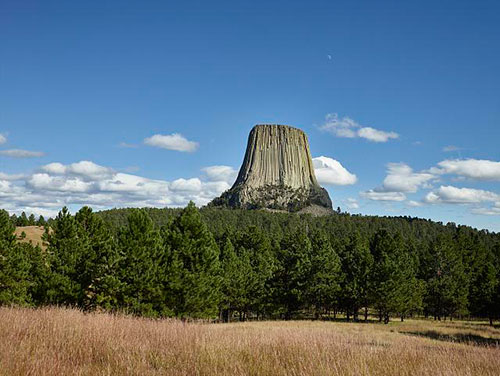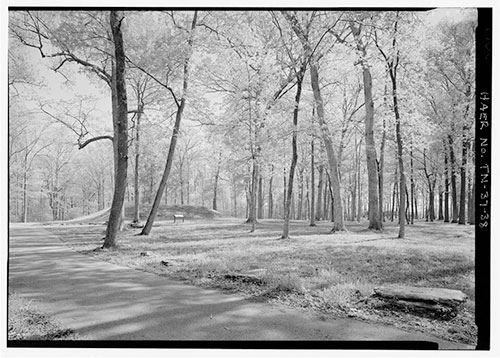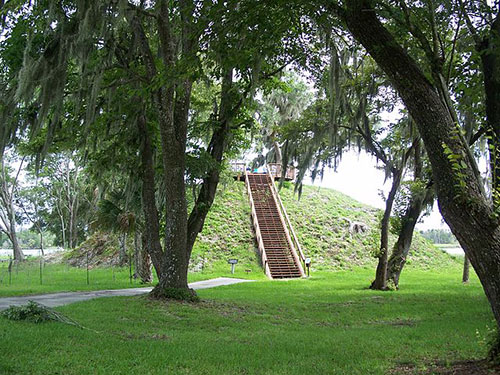by
Willa Granger, University of Texas at Austin | Sep 08, 2017
Willa Granger
Summary Report Summer 2017
University of Texas at Austin
Graduate study is often a tensile combination of broadening and winnowing: broadening one's knowledge of the field, while winnowing one's area of expertise. And while my schoolwork so far has certainly been exploratory, I only seem to do research and writing in the latter, honing my methodological program and scope of focus. So when I was given the task of writing about Native American architecture as part of the Charles E. Peterson Fellowship—a subject beyond my academic wheelhouse—I was ecstatic. I saw it as both a challenge and a welcome respite, this opportunity to explore new subjects. And, as I quickly learned, it was to be a completely different ball game.

Devils Tower, Wyoming. (Carol M. Highsmith Archive, Library of Congress)

Shiloh Indian Mounds, c. 1100-1300 CE. (Historic American Engineering Record, Library of Congress)
Part of this challenge has to do with the paucity of academic writing to begin with. It should come as no surprise that the Eurocentric perspective of architectural history tends to neglect indigenous environments. In my own undergraduate survey courses, we never looked critically at Native American architecture. There are only a handful of synoptic texts that deal directly with Native American studies through an architectural lens; moreover, much of the extant research and writing in this field is drawn from disciplines that I rarely interact with such as archaeology, geology, and anthropology. This leads to a complex process of interweaving information from multiple sources or, oftentimes, not finding the requisite answers at all.
Another factor I had to consider was the at times ephemeral quality of a given tribe's built environment. This is best exemplified by the Karankawa of the Texas Gulf Coast, a group that created wigwam-like dwellings from willow branches, which they merely bundled up and carried with them from camp to camp. In such cases, archaeologists turn to other indicators of human activity such as shell middens and post mold remains—evidence that is beyond the material proof that architectural historians typically rely upon. A further consideration throughout my research was the materiality of building itself: the Calusa, for example, moved, shaped, and thoughtfully piled sand, earth, and shells to create mound complexes. Tribes of the Colorado Desert used scraping techniques to remove thin lines of topsoil, thereby creating massive, representational imagery. Many of the materials and techniques used for shaping the environment were again beyond my wheelhouse.
For the shorter SAH Archipedia entries, I tried to explore diverse typologies, communities, and geographies. These included the intaglios of Blythe, California, two separate mound complexes in Florida, and another mound site in Tennessee. I also wrote an entry on the Devils Tower, in the Black Hills of Wyoming. The decision and process of writing this entry exemplifies the unique considerations of documenting Native American built environments: a natural rock butte, the Devils Tower has become incorporated into the spiritual and ancestral lives of numerous tribes, serving to shape both space and movement in a way that built forms typically do. As the Traditional Cultural Property (TCP) category within the National Register of Historic Places suggests, preservationists, anthropologists, and historians must broaden the scope and parameters of what defines the built environment.

Crystal River Archaeological State Park, Temple Mound A, Florida. 300 BCE-600 CE. (Creative Commons)
My extended essay idea came from a trend I noticed across the larger literature regarding Native Americans, which was the regional division of areas throughout the United States. Often these groupings seemed geographically massive and random, and I was curious to assess how a specific shared feature—such as the Gulf of Mexico—affected the built environments of differing tribes. Again, the sheer paucity of literature about this subject meant that I had to cobble together research in a synthetic matter, at times favoring tribes that simply had more archaeological and historical writing on their buildings.
To a certain degree, this research experience has taken me full circle. As an undergraduate, the Philadelphia Athenaeum was one of my first points of departure into my interest in architectural history. As I complete my master's degree and enter into doctoral studies, the Athenaeum—along with the SAH—has yet again provided me the opportunity to both support and explore the field.